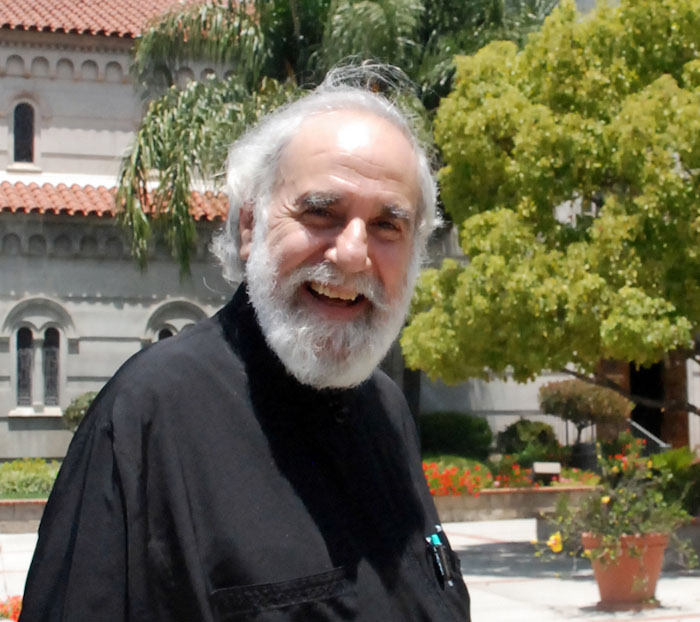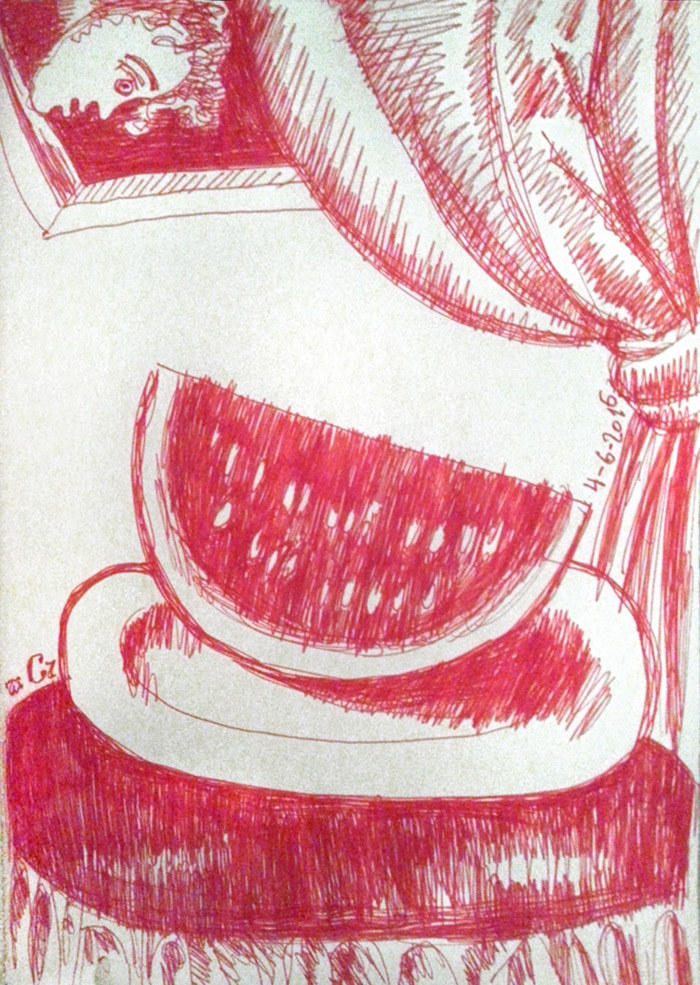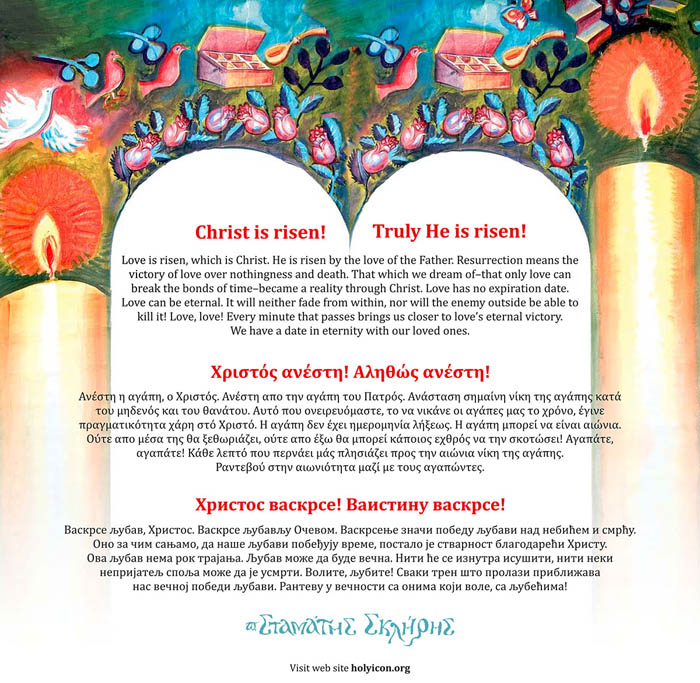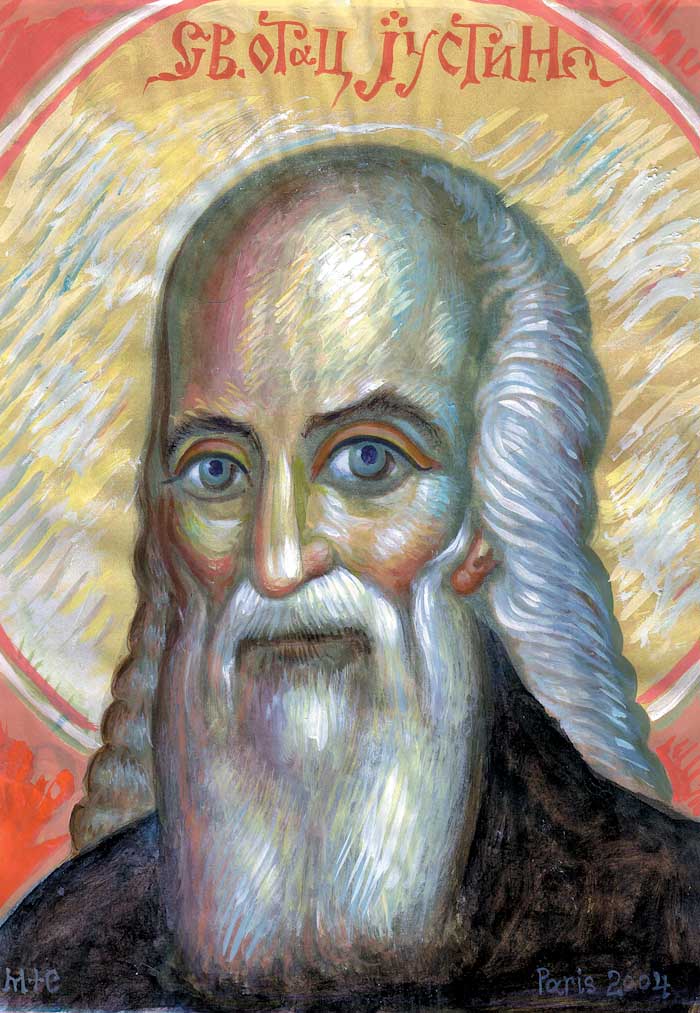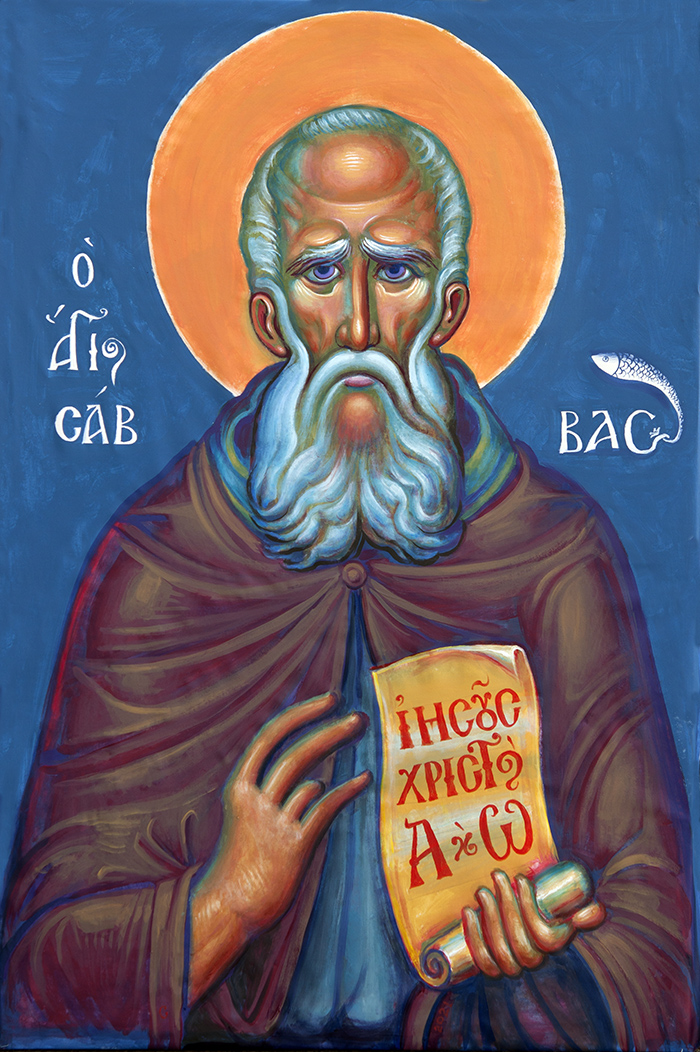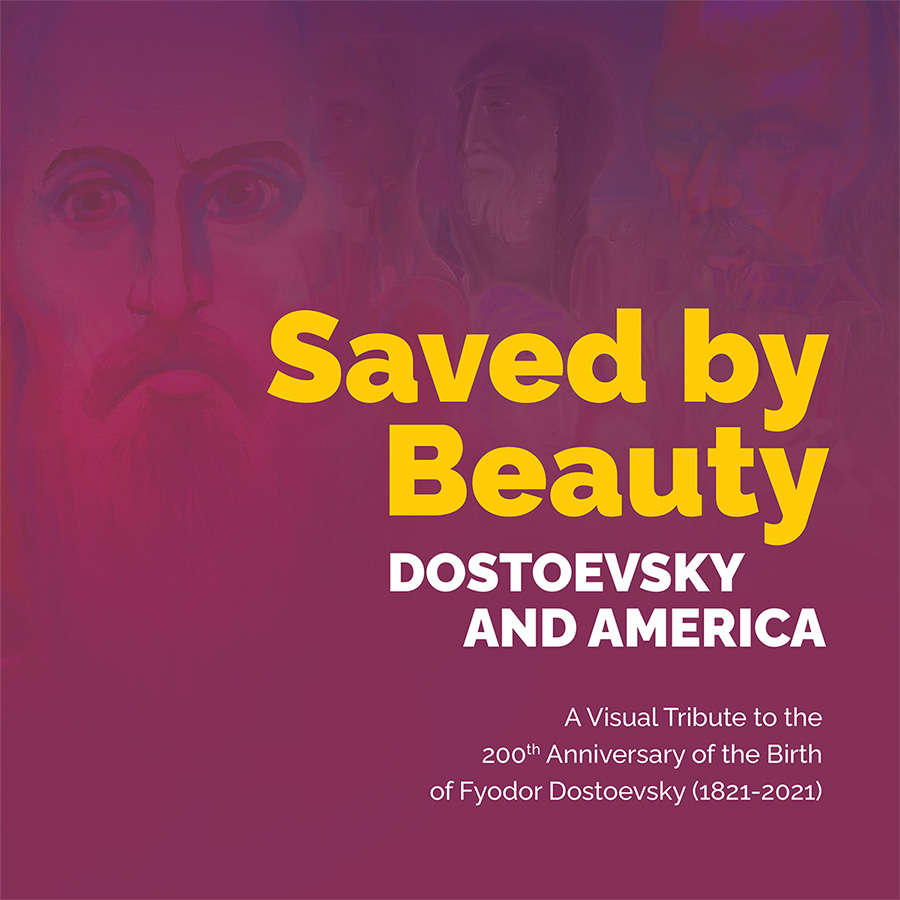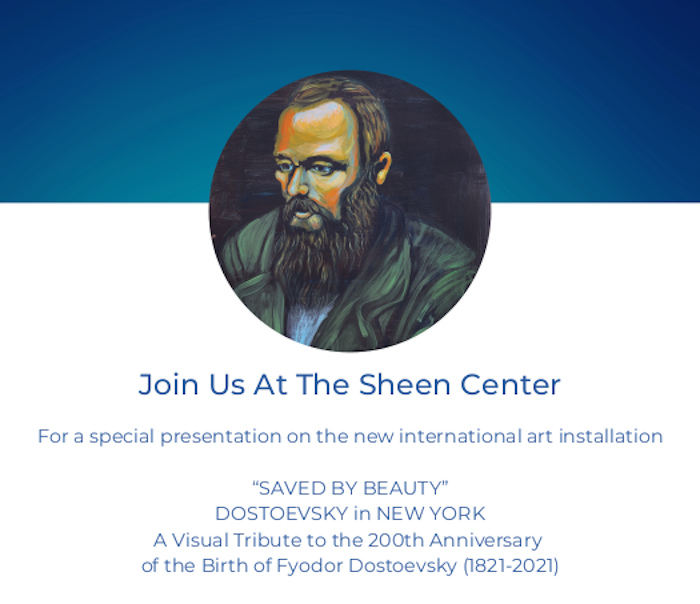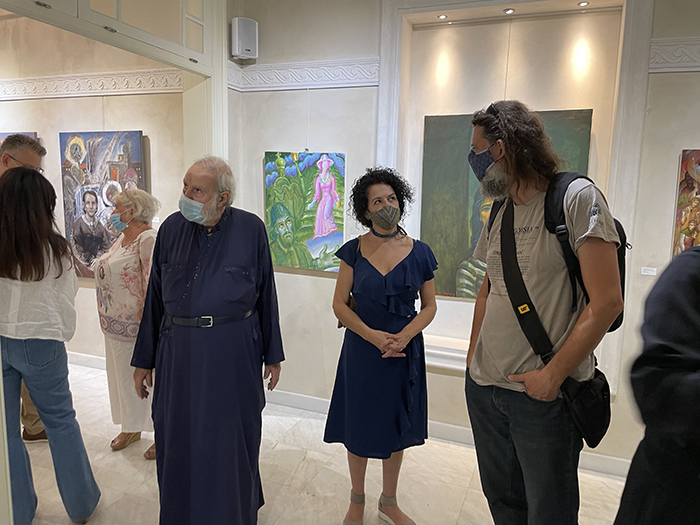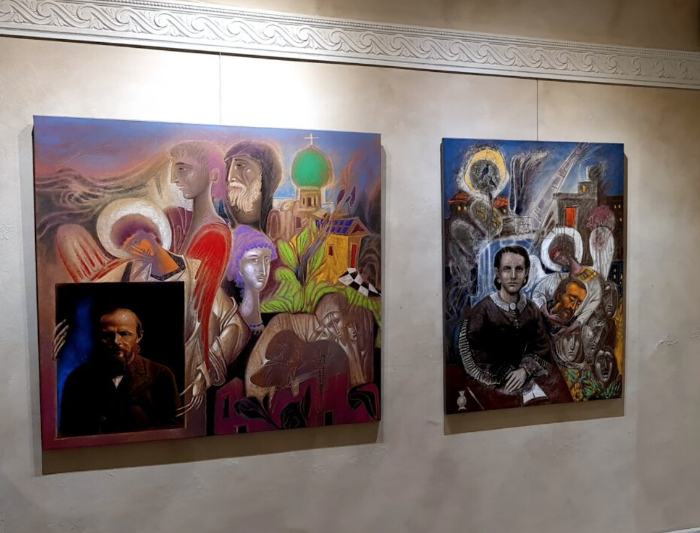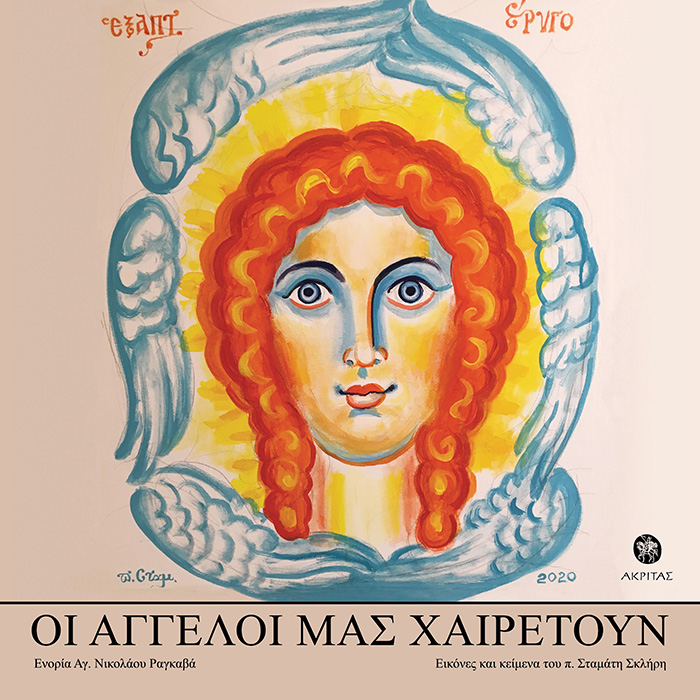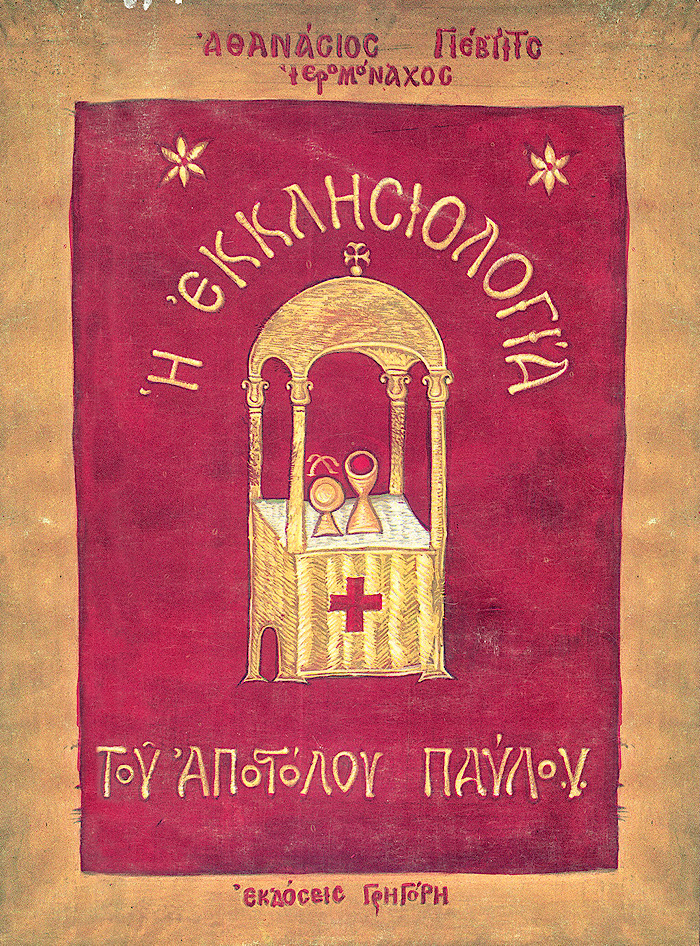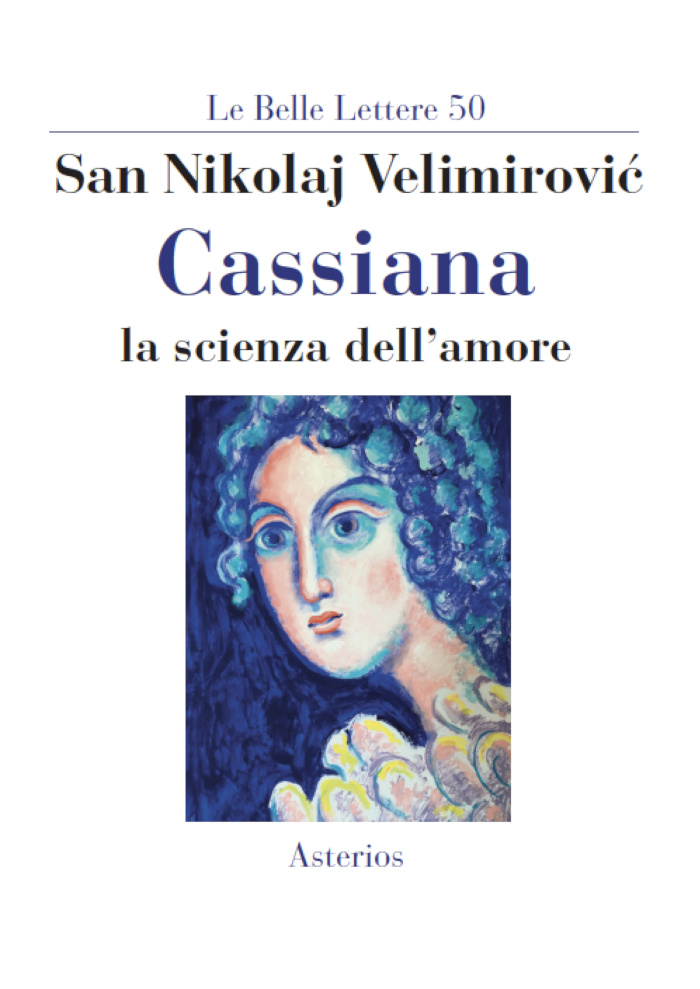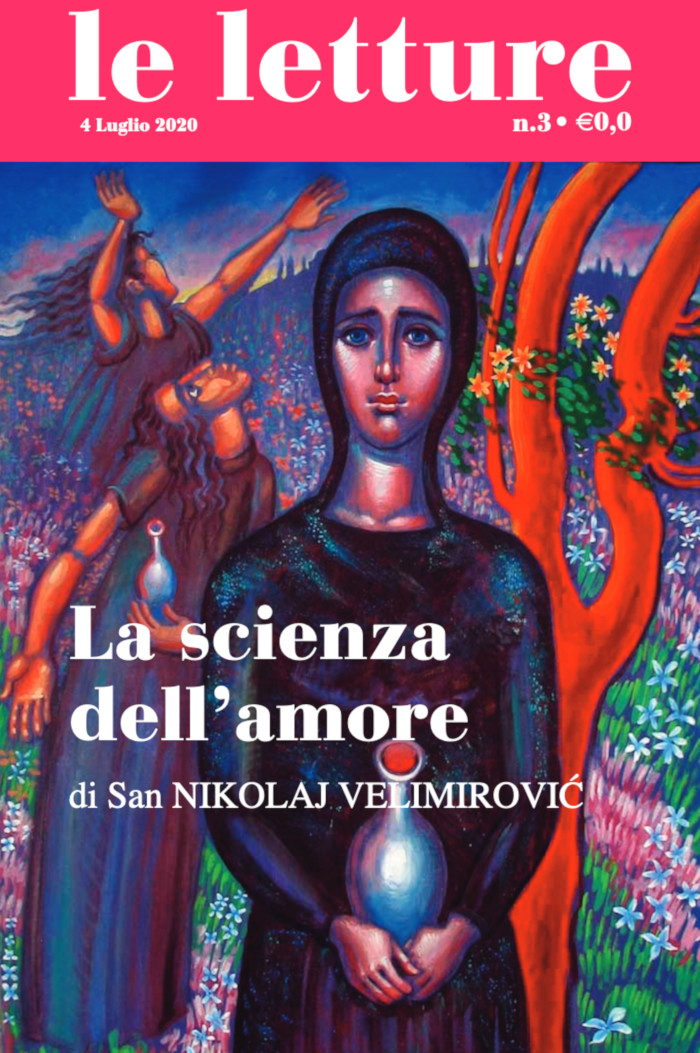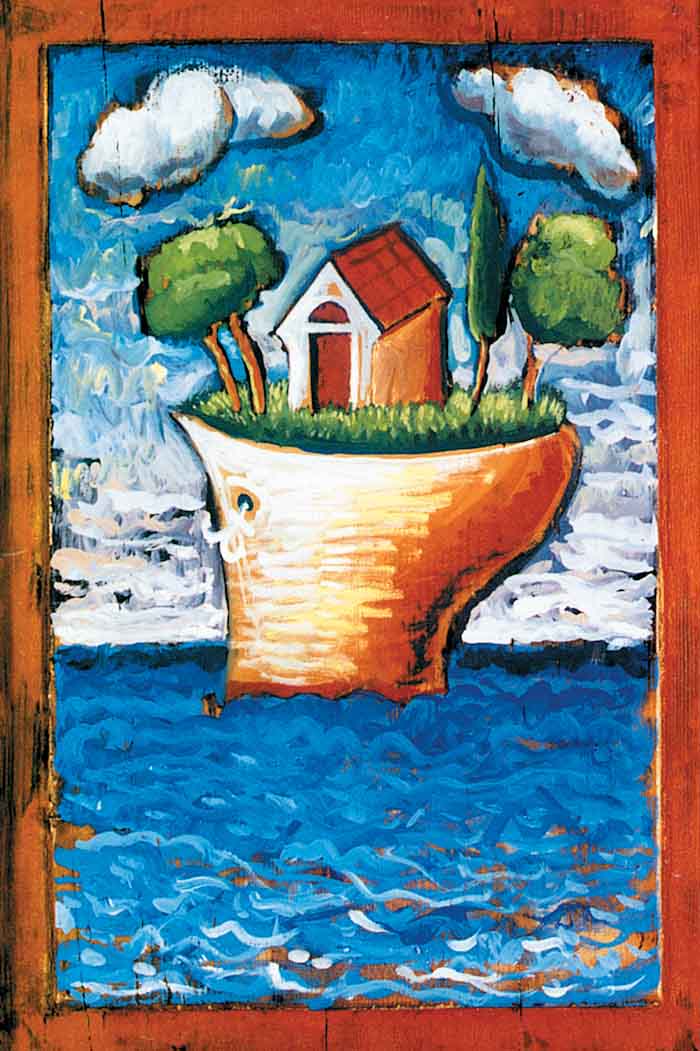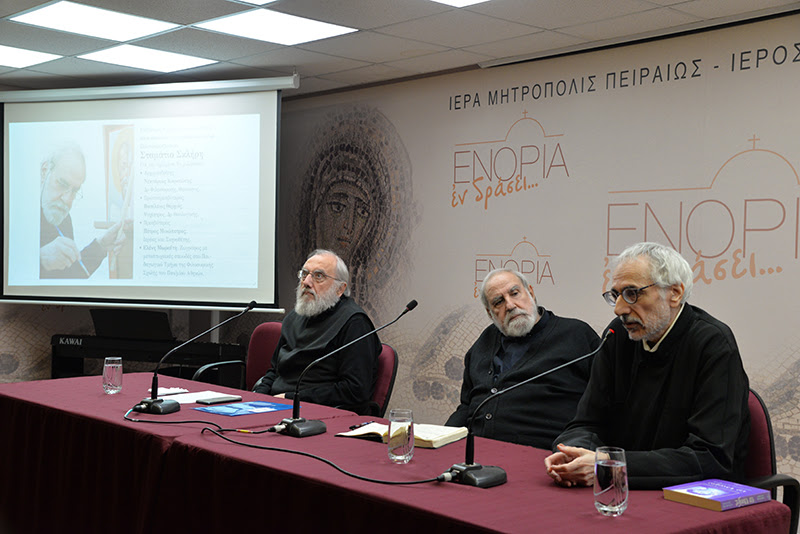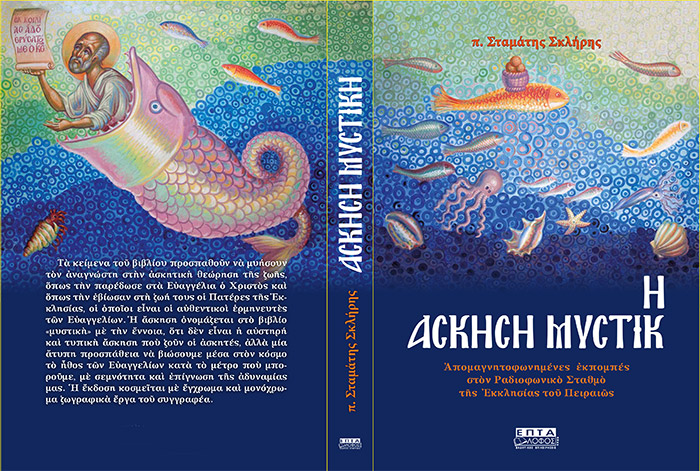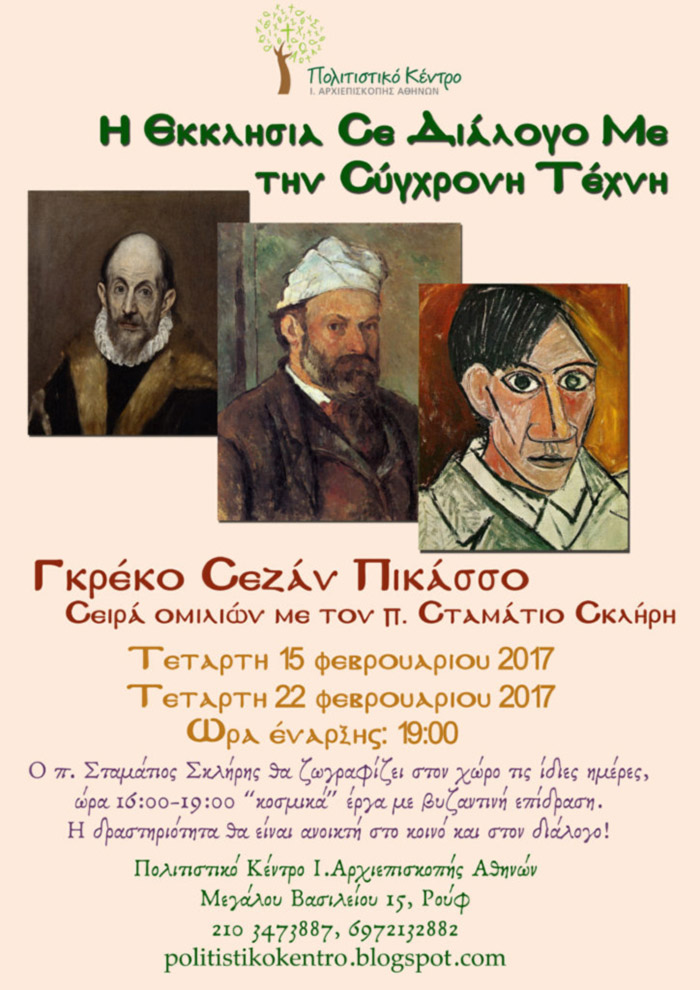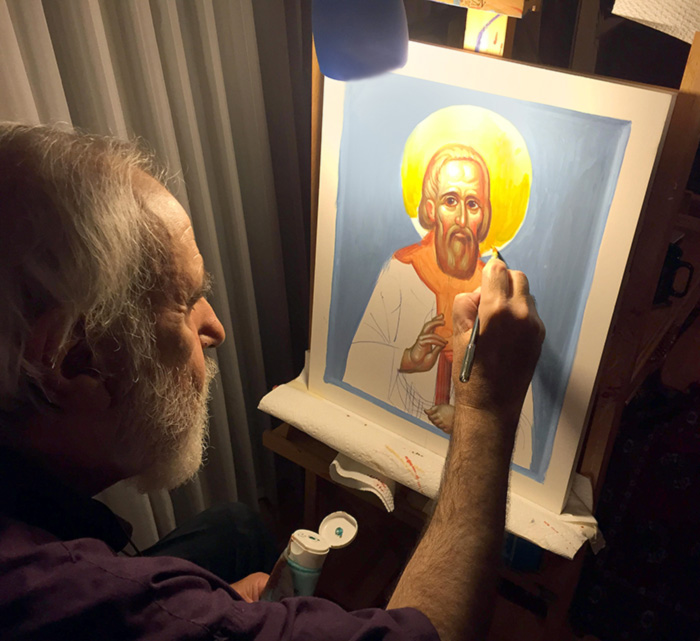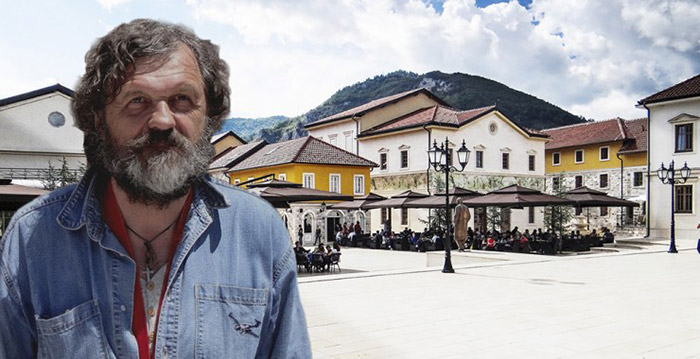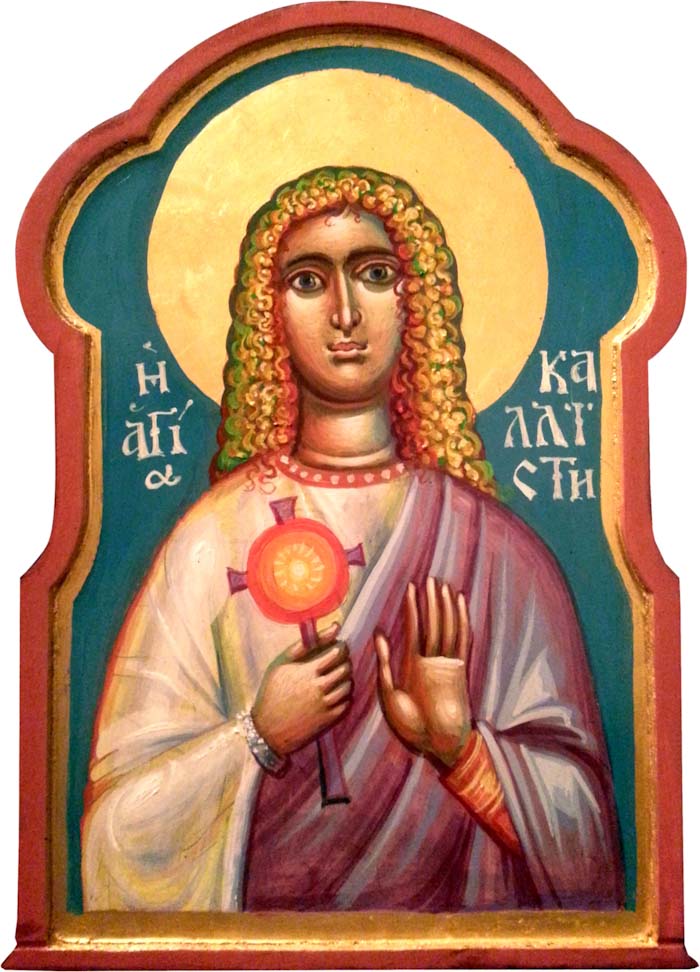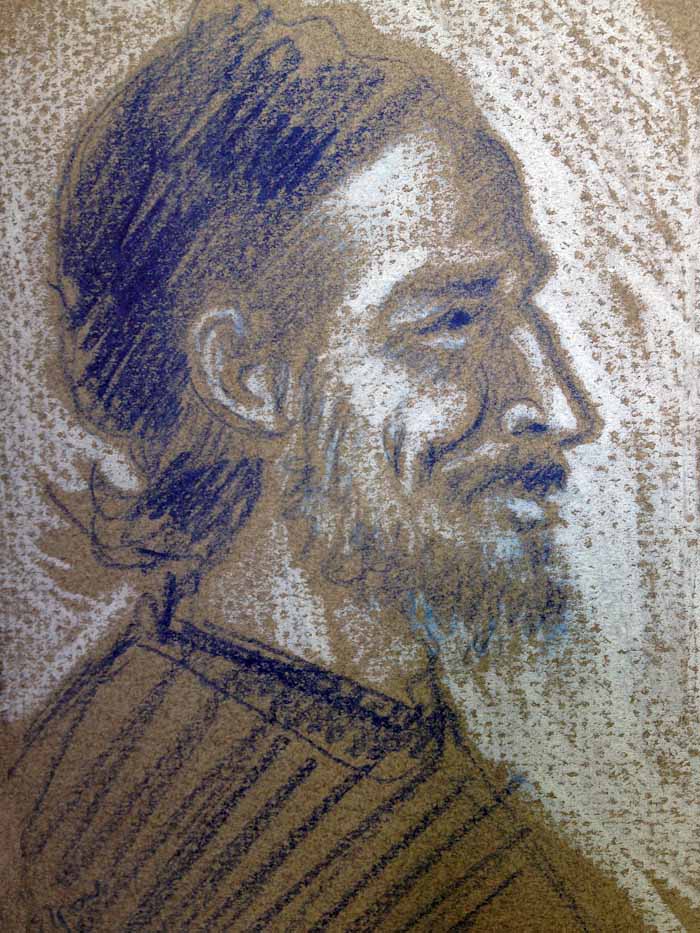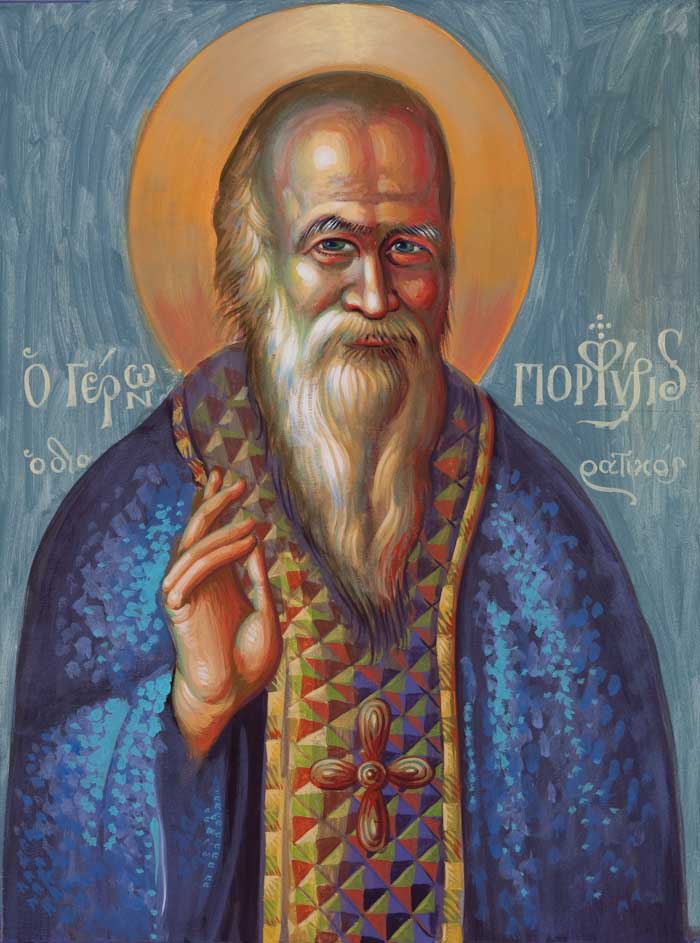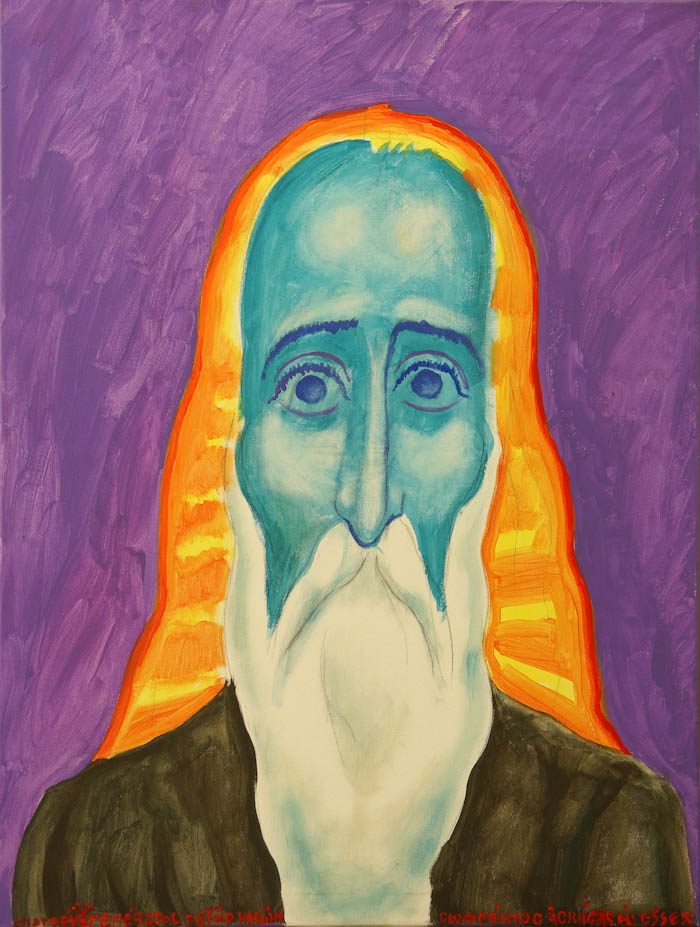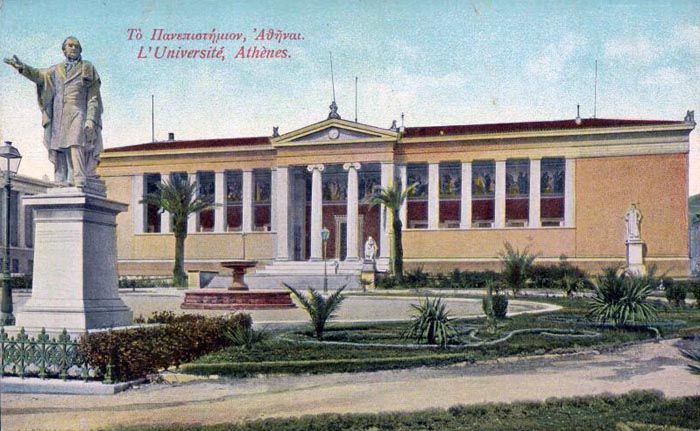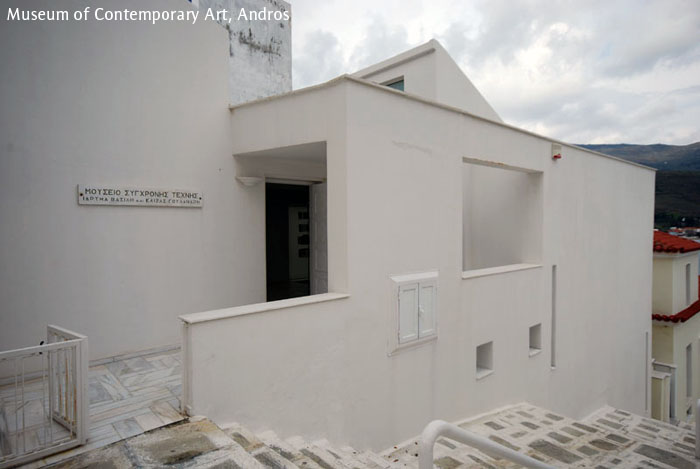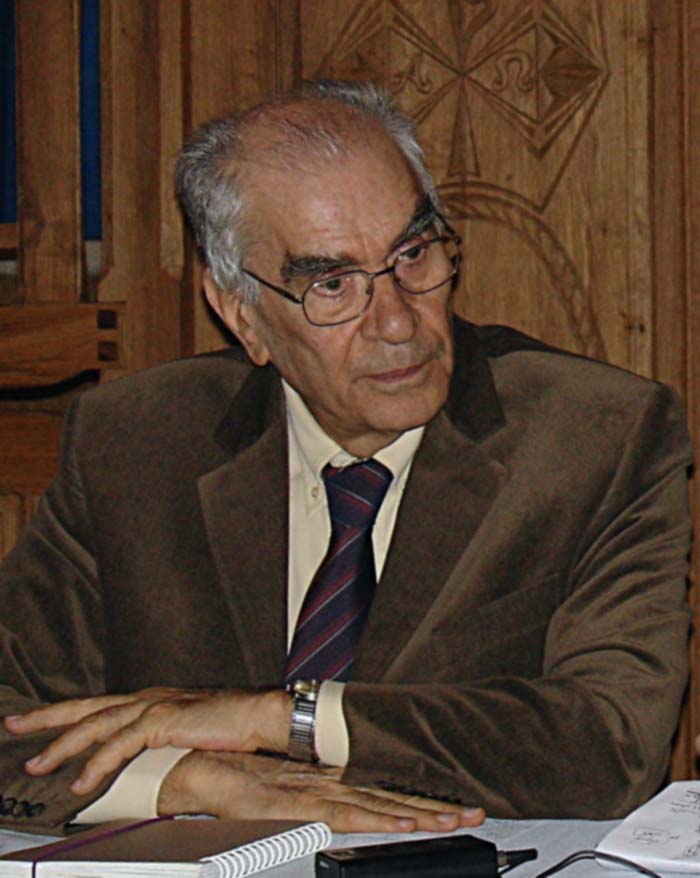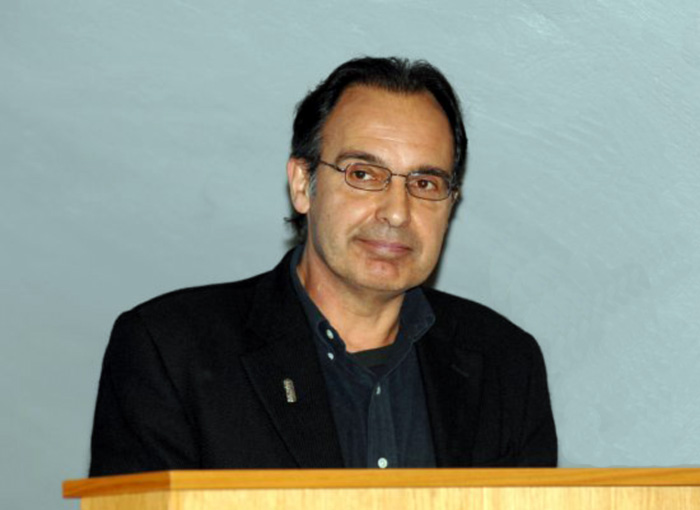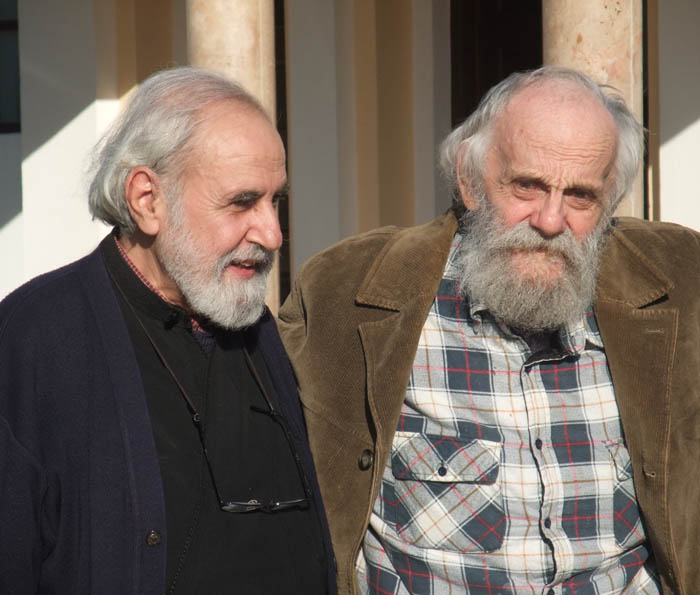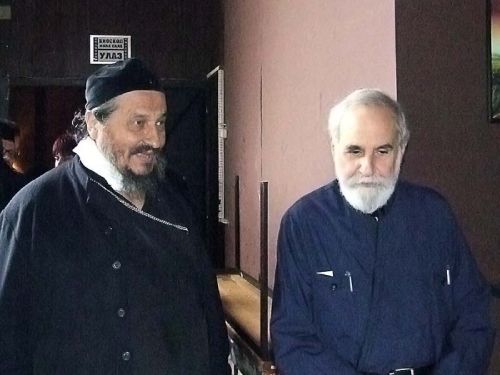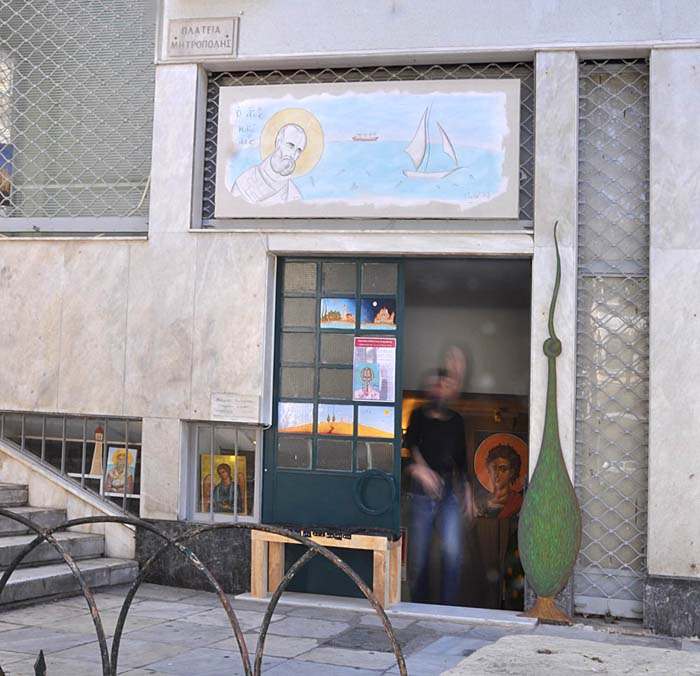Father Stamatis Skliris was born in Piraeus, the port of Athens, in 1946. At his baptism he was named after Holy New Martyr Stamatios from the island of Hydras. From the early childhood, he showed the artistic gifts and through his elementary and high school education, he began to paint and write church poems. Initially he completed the Medical faculty (1971), and then Theology (1976) at the University of Athens. He continues his studies in Belgrade at the Theological and Philosophical Faculty, attending lectures in Theology and Art History. His love and zeal for Theology and Art, defined him as one of the most knowledgeable Orthodox iconologos, iconographer and technotrope (designer and stylist) of icons, as well as of the ancient, medieval and modern art.
Along with his wife Marina he spent two years in Serbia, mostly in the Monastery of Cheliye, in the immediate vicinity of Fr. Justin (Popovic) – today St. Justin of Cheliye. During that period he decorated the monastery chapel devoted to St. Stefan the Decansky. He was initiated into the priesthood and since 1979. he has been serving in Athens.
This website is the definitive reference for information about his life and work, bringing a splash of color to the largest collection of Stamatis Art in the world. With a click you can see a complete inventory of his works, read a short biography, learn how his art is made, check his calendar of upcoming events, view some recent commissions, or make a purchase.
"From a particular moment onwards our traditional art had touched upon my heart. I thought I had discovered a kind of a hidden, mystical beauty. I bathed in the light of the Byzantine icon regarding everything else as being secondary. However, I needed to find a way—after having lived out tradition internally—to express it in my own work in relation to the issues of our time. That is: I needed to act just as an ancient Hellene or a Byzantine would act if living in our times. I borrowed the bright colors and brilliant brush strokes from Impressionism and clothed them with the centripetal lighting of an Icon. It is thus, in my opinion, that emerged an art of painting similar to the Hellenistic, Greco-Roman, but, simultaneously, both Byzantine and modern. In other words, the East has moved closer to the West, and the so called secular art to that which is seen as sacred."
TO ALL VISITORS OF HOLY ICON WEBSITE FR STAMATIS WISHES
♡ ΚΑΛΟ ΚΑΛΟΚΑΙΡΙ ♡ HAPPY SUMMER ♡
Christ is risen! Truly He is risen!
Love is risen, which is Christ. He is risen by the love of the Father. Resurrection means the victory of love over nothingness and death. That which we dream of—that only love can break the bonds of time—became a reality through Christ. Love has no expiration date. Love can be eternal. It will neither fade from within, nor will the enemy outside be able to kill it! Love, love! Every minute that passes brings us closer to love’s eternal victory. We have a date in eternity with our loved ones.
By Bishop Maxim (Vasiljević)
Stamatis Skliris’ contribution to modern art (both Church art, and art in general) through his painting and iconography is already a generally established fact. With this review we would like to sketch the historical context behind the appearance of Skliris the zographos (i.e. one who paints from life or from nature using fresh, natural colors) and, by making a theological-aesthetical analysis of his iconographic opus, to emphasize clearly and objectively some of the particular qualities of his art in relation to the iconography of the second half of the twentieth century.
By Metropolitan of Pergamon John (Zizioulas)
Finally, the main characteristic of Fr. Stamatis’ paintings is the gaze. Although his work encompasses many forms of painting – frescos, icons, pictures, book illustrations, etc. – and although it employs various techniques and styles, there is something common to all of it that unites everything and that gives everything a stable identity. This characteristic is the gaze from the image. Inall the painted images by Fr. Stamatis, the gaze is “questioning.” As in the Psalms God “searches the hearts andreins” (Ps. 7:9), so also the gaze of these paintings questions and inquires about the existential depth of the picture’s observer.
A Collection of Iconographic Essays and Illustrations by Fr. Stamatis Skliris
The Serbian Orthodox Diocese of Western America is pleased to announce the publication of an outstanding book by Fr. Stamatis Skliris, a disciple of the great twentieth-century theologians Archimandrite Justin Popovich and Bishop Athanasius Yevtich. Fr. Stamatis is a parish priest in Athens and is renowned as an iconographer and as a writer and lecturer on Byzantine iconography.
Within an Athenian church, Father Stamatis Skleris anchors a celestial passage, baptizing Avgerinos and Stergiani's child in waters reflecting heaven's threshold. The infant's innocent form shifts realms beneath the surface, his cries a primal hymn to the sanctity enveloping him. Surrounding souls partake in this divine blessing, a community woven into the child's nascent tapestry of existence. Here, in a mystery transcending time, a delicate miracle unfolds, heralding a journey anew in the sacred echoes of ancestral faith.
Fr. Stamatis Skliris
When we are on the bus and we arrive at the bus station, we see genuine faces and glances. Nevertheless, cinema and fashion have instructed people to be pretentious and to adopt a fake manner of standing, speaking, and moving. This constitutes an alienation of the human person. As an artist, I strive to discover the real humanity. We have even lost the scent of carnation. The sellers of carnation say that the scent is gone, even though the form remains the same. It is carnation in the form, but it is not full since it has no particular scent. As an iconographer, I have to depict a saint. The saint is a man who stands before God and before his fellow man with love. He is in a state of confession. Me too; I am in a state of confession at this moment. I am trying to express what is my problem. As the ancient philosopher Diogenes said, “I am searching for a man.” Indeed, we are searching nowadays for a man who does not seek one’s self-interest, who is not cunning and devious. We are accustomed to playing roles; honesty is thus tricky. One way would be to depose the masks we are searching for and find the true “me.” And if I find the true me, I can see the true “you”.
A Visual Tribute to the 200th Anniversary of the Birth of Fyodor Dostoevsky (1821-2021)
Download PDF CATALOG
The bicentenary celebration of the birth of the great Russian author Fyodor Dostoevsky (1821-2021), considered one of the most outstanding writers of modern literature, has found the world in an increasing state of bewilderment. Some believe that the dynamic and open anthropology of this classic can help rectify an issue because it has the power to break the defensive armor of the modern ego and take us beyond its ideological constraints.
March 18 – April 30, 2022
Gallery Exhibition | Free Admission
Gallery Hours: Monday – Friday 11:00 a.m. to 7:00 p.m. | Saturdays 12:00 p.m. – 7:00 p.m.
“Man can live without science, he can live without bread, but without beauty he could no longer live.” -- Fyodor Dostoevsky (from the novel Demons)
Exhibition of Fr Stamatis’ paintings in Trebinje, 1998, on the occasion of celebration of 800 years of Hilandar Monastery
"THE DREAM OF A RIDICULOUS MAN"
A Visual Tribute to the 200th Anniversary of the Birth of Fyodor Dostoevsky (1821-2021)
Visit PHOTO GALLERY FROM THE EXHIBITION
Painting exhibition of the group “OCHRE” in the METS Art Gallery, 6 Eugeniou Voulgareos in METS, Athens, September 17, 2021.
"OCHRE" is an informal group of painters, who have contributed to the traditional Orthodox iconography but at the same time are in dialogue with the modern artistic trends. The exhibition is organized with great passion by the 16 artists and has exceeded all expectations.
Εικαστικό αφιέρωμα στα 200 χρόνια από την γέννηση του Φιόντορ Ντοστογίεβσκυ. Στο κέντρο τεχνών ΜΕΤΣ (ευγενίου Βουλγάρεως 6, Μετσ). Εγκαίνια 17 Σεπτεμβρίου 2021 (7μμ-10μμ). Διάρκεια μέχρι 15 Οκτωβρίου.
Συμμετέχουν οι εξής καλλιτέχνες: Επίσκοπος Μάξιμος Βασίλιεβιτς, π. Σταμάτης Σκλήρης, Μπάμπης Πυλαρινός, Κώστας Λάβδας, Μαρία Πάνου, Γιαννούλης Λυμπερόπουλος, Νεκτάριος Μαμάης, Φώτης Βάρθης, Κωνσταντίνος Κουγιουμτζής, Χρήστος Κεχαγιόγλου, Νεκτάριος Σταματέλος, Γκόρντανα Ραντόγιεβιτς, Δέσποινα Καραντάνη, Γιώργος Μαργαρίτης, Χριστίνα Παπαθέου – Δουληγέρη, Γιώργος Κόρδης.
Η αίθουσα τέχνης είναι ανοικτή Τρίτη, Πέμπτη, Παρασκευή απόγευμα (6μμ-9μμ) και Σάβατο πρωί (11πμ- 2μμ). Θα χαρούμε να συναντηθούμε εκεί και να χαρούμε όλοι μαζί τους εικαστικούς διαλόγους των συμμετεχόντων σύγχρονων έλλήνων δημιουργών με το πρόσωπο και το έργο του μεγάλου ρώσου δημιουργού.
Source: kordis.gr
ΗΜΕΡΟΛΟΓΙΟ 2021
Από τις εκδόσεις Ακρίτα κυκλοφορεί το επιτοίχιο Ημερολόγιο της Ενορίας του Αγίου Νικολάου Ραγκαβά στην Πλάκα για το 2021.
«Οι Άγγελοι μας χαιρετούν» με 13 αδημοσίευτα έργα του Αγιογράφου και Θεολόγου, π. Σταμάτη Σκλήρη.
Bookcover for "Ἡ Ἐκκλησιολογία τοῦ Ἀποστόλου Παύλου κατὰ τὸν ἱερὸν Χρυσόστομο" by Hieromonk Athanasios Yevtich, acrylic on cardborad, 1984.
La scienza dell'amore
Autore: San Nikolaj Velimirović
A cura di: Antonio Ranzolin
Traduzione di: Antonio Ranzolin
Autore: San Nikolaj Velimirović
Traduzione di: Antonio Ranzolin
By Bishop Ignatije (Midić)
Church art, and thereby art of painting, cannot be independent from the Church and its own truth. It is expressing, or it is attempting to express, the truth of the Church. But, when we talk of the truth of the Church, as is the case with the truth of other beings and types of communion, we come to the conclusion that the truth is not so easily perceptible for everything and to all; especially so because the truth is mixed with something which is not the truth, but which is the destiny of every being in existence in history, and thus also of the Church itself. What is the truth of the Church?
Αποτελεί έναν γνήσιο άνθρωπο του Χριστού, της αγάπης εν ελευθερία. Λαχταράει την βασιλεία του Θεού και αυτό φαίνεται και από την ζωγραφική του, με τα λαμπερά χρώματα, όπου όλα είναι λουσμένα από το φως της αγάπης του Θεού.
Του Σταμάτη Μιχαλακόπουλου
Εκδήλωση τιμής και ευγνωμοσύνης στον Θεολόγο, Αγιογράφο και Ιατρό Πρωτοπρεσβύτερο Σταμάτιο Σκλήρη, πραγματοποιήθηκε την Κυριακή 8 Δεκεμβρίου, στο Πνευματικό Κέντρο του Ιερού Ναού Ευαγγελιστρίας Πειραιώς, στο πλαίσιο του προγράμματος «ΕΝΟΡΙΑ εν δράσει…».
Τα κείμενα του βιβλίου προσπαθούν να μυήσουν τον αναγνώστη στην ασκnτική θεώρησn τηs ζωης, όπωs την παρέδωσε στα Εύαγγέλια ο Χριστόs καί όπωs την έβίωσαν στη ζωή τουs οι Πατέρεs της Εκκλnσίαs, οι όποιοι είναι οί αυθεντικοί ερμηνευτέs των Ευαγγελίων.
Ο πνευματικός μου πατέρας είναι ο Γκρέκο είχε πει ο Σεζάν. Ο πατέρας μου είναι ο Σεζάν και ο παππούς μου ο Γκρέκο, είχε πει ο Πικάσο.
Τρεις μεγάλοι ζωγράφοι. Έζησαν σε μεταίχμια εποχών. Τρεις επαναστάτες που ξέφυγαν από την πεπατημένη. Πολλαπλές οι αναγνώσεις των έργων τους. Και των τριών τα έργα διακρίνονται σε περιόδους. Δεν έμειναν στάσιμοι. Αφομοίωσαν παραδόσεις χωρίς ποτέ να γίνουν αντιγραφείς. Επηρέασαν και άνοιξαν νέους δρόμους για τους καλλιτέχνες.
Born on June 21, 1863 in San Francisco, Sebastian Dabovich, now Saint Sebastian, was the first Orthodox Christian priest born in the United States. Born in San Francisco, California in 1863, the son of one of the earliest known Serbian immigrants to the United States, he was well known for his missionary-apostolic work establishing Orthodox Christian parishes all along the West Coast, including the first distinctly Serbian Orthodox parish in Jackson, California in 1892. The church building there, still home to an active parish, is an officially designated National Historical Landmark. Fr. Sebastian produced inspiring homilies in English, Serbian and Russian, as well as several books in English for missionary needs.
This is a unique portfolio of hitherto unpublished works by Father Stamatis Skliris, based around the theme of man’s perception of the divine, sacred, blessed face of this world and the world beyond. It immerses us in the ineffable depths of Byzantine art, as this has survived over the centuries of man’s attempt to depict the sacred, and as it has evolved in our day, mediated through the attentive vision of Father Stamatis Skliris, priest, doctor and icon-painter.
Разговор оца Стаматиса Склириса и Емира Кустурице
Разговор је вођен на Црквини у Требињу, крајем јуна 2014.
By Fr. Stamatis Skliris
From time immemorial, through the sprawling labyrinths of time, over the misty highlands of earth, across the vast expanses of space, through grandiose reflections of things past and future—likely and unlikely outcomes, murky speculations, cavernous fantasies, and foggy uncertainties of what exists, existed, will exist, or did not exist, or what is decreasing or increasing, or what is being conceived, or what is latently inconceivable—all races, all genders, all human societies, and every person individually who has wanted to be unique, who has wanted to be god, every single one of them has contributed to painting a portrait of God.
Père Stamatis Skliris
Cézanne disait que El Greco était son père en la peinture. Picasso disait que Cézanne était son père et El Greco son grand-père. Si Cézanne était le fondateur et Picasso le principal représentant du modernisme, nous pouvons supposer que El Greco a introduit quelque chose de nouveau dans l'art de la Renaissance qui a finalement conduit à l'art moderne. Nous présumons que ceci a un rapport avec les racines byzantines de Greco qui,dans sa jeunesse, peignait des icônes byzantinessur son île natale de Crète. Cet élément, qu’on considère nouveau et subversif pour la Renaissance, existait bien avant dans la peinture byzantine.
Saint Kallisti
I often borrow elements from different artistic periods in the service of the icons I paint. This icon of St. Kallisti was ordered by someone in the Crimea. It was painted on Saturday 7 June 2014. Some people may not like it, but it may just be an authentic portrait.
By Fr. Stamatis Skliris
You could say that nowadays our faces are copies of one another, and that all of us are copies of the general models of fabricated [false] life. A perfect example are the stars of Los Angeles. Similarly, the faces painted by contemporary iconographers are poor models (falsely referred to as "Byzantine") of an insipid, monotonous, and repellant repetition. These images portray an army of false saints, rather than unique and unrepeatable persons.
By Fr. Stamatis Skliris
Seek sensitivity everywhere, so that you may stumble upon it both in life and in nature. In your painting, do not adhere strictly to the existing art movements. Don't be preoccupied with the main subject you are trying to paint, nor with the artistic values, as they are called by aestheticians and art critics. Or, to put it better, solve your art issues as if they were humanity issues, visually transposed to sensitivity issues. This is to say, when two or three thin lines impose themselves, articulating the fine expression of lines and shadows, it is a way for the human spirit to materialize in human likeness. The same applies in the imposition of a certain sensitivity expressed by colours. Here again, we can see that the man is a being "not of this world".
André Tzourakis, Journaliste
Quotidien «I Kathimerini», Dimanche 15 décembre 1991
... L'observateur attentif percevra que ces icônes-portraits, ces dessins, ces gravures et ces compositions libres du père Stamatis sont comme les tentatives fragmentaires qui pourraient enfanter un résultat esthétique, révolutionnaire, en ce qui concerne une grande partie de notre héritage traditionnel.
Nikos Zias, Professor at the Faculty of Philosophy of the University of Athens
Man is the chief subject of paintings by Father Stamatis Skliris—man in his two aspects: redeemed and deified through grace, bathed in divine light, and at the same time confined by his own isolation and his quests.
Kyriakos Koutsomallis, Director of the Museum of Contemporary Art in the island of Andros, Basil and Elise Goulandris Foundation.
It was a pleasure to receive Father Stamatis Skliris’ invitation to visit him at his studio in Paris. Conversation with him is an intellectual stimulus. His figurative language is on a level with his cogent dialectic. It is dynamic and carefully structured, and it makes no secret of the kind of relationship he wishes to suggest by the natural world he represents in his painting.
Les recherches du père Stamatis Skliris
Christos Yannaras, Professeur de Philosophie à l'Université Panteios d'Athènes
Les recherches du père Stamatis Skliris ont transformé – transmué sans le diviser – le médecin en théologien, le théologien en prêtre, le prêtre en iconographe et l’iconographe en peintre. Des bonds de rapide maturation qui visent des choix essentiels. Rien n'est laissé au hasard et le tout compose une naïveté unique, pleine de grâce d’exigences enfantines. Ce qui domine toujours dans son itinéraire, c’est une approche tangible des recherches essentielles: le corps humain, le pain et le vin de l'Eucharistie, et ces «remontées vers le prototype», qui procèdent par les couleurs et mènent de la peinture iconographique vers la chair picturale de notre époque.
Τα αμερικάνικα τοπία του Παπασταμάτη
Το δράμα της εποχής είναι πως η διαφήμιση, η κατανάλωση και η κουλτούρα μπορούν να ταυτίζονται.
Παναγιώτης Κονδύλης, φιλόσοφος (1943-1998)
Στην εποχή που οι εικόνες κατακυριεύουν τα πράγματα επειδή η ορατότητα κατάντησε δυνάστης και που υπάρχει μόνο ό, τι φαίνεται, η ζωγραφική ζητεί εκ νέου να εκπληρώσει την παλιά της αποστολή: Να μεσιτεύσει δια του ορατού στο αόρατο και να ξαναδιεκδικήσει τη ψυχή των πραγμάτων κατοχυρώνοντας όμως πάνω απ’ όλα το σώμα τους.
Kosta Bradich, academic painter
It is without a doubt a problem to speak, to write, to use words in order to explain that which is being iconised by fine art. If this should at all be possible, then the art of painting would not be necessary. However, I shall try to present my impressions regarding images on Fr Stamatis’ icons and frescoes.
Inspired by the painting of the National Parks of America
Fr Stamatis Skliris
We walk on the very crust of the earth. Beneath us, a seething hot sun is hidden in a damp fiery form. Landscape painting is the portrayal of this crust, since the painter's main concern is the rendering of three-dimensional space on a two-dimensional canvas. This burning sun wears its lava as a dried up skin that swallows up the flames.
Performed by Fr Stamatis Skliris
California, 2013
Portrays and places of American landscapes arranged through Orthodox Iconography in an unprecedented way, blending the Byzantine tradition with influences of contemporary arts, paintings and images, creating exciting canvases that transport the viewer to new realms of delight and inspiration.
π. Σταμάτης Σκλήρης
To να δημιουργήσεις μιαν εικόνα είναι ταυτόχρονα και καλλιτεχνική δημιουργία και Θεολογική δημιουργία. Ο αγιογράφος επομένως πρέπει να αγωνίζεται, ζώντας μέσα στην Εκκλησiα την όλη εκκλησιαστική ζωή, να αναδεικνύεται με τη χάρη του Οεού ευαγγελιστής του πληρώματος της Εκκλησίας. Ταυτόχρονα ως προς το καλλιτεχνικό μέρος πρέπει να αγωνίζεται σαν μέλος της Εκκλησίας να ελαχιστοποιεί τις καλλιτεχνικές εμπάθειες. Κάποια πάθη δηλαδή, τα οποία για έναν καλλιτέχνη κοσμικό μπορεί να Θεωρούνται νορμάλ, ενώ για τον αγιογράφο αποβαίνουν επικίνδυνα. Δiότι φαλκιδεύουν την πνευματική πλευρά της εικόνας.
St. Gregory Palamas and the Essence of Hesychasm
The following is translated from a talk given by His Grace, Atanasije (Jevtić), Retired Bishop of Zahumlje and Herzegovina (Serbian Orthodox Church), at the Sretensky Seminary in Moscow on November 1, 2001.
Today we will be speaking about St. Gregory Palamas and the essence of hesychasm. The Council of Constantinople in 1351, which took place 650 years ago, clearly and definitively affirmed the experience and theology of hesychasm. The first such council had met ten years earlier, in 1341, at which Palamas and his Athonite monks presented the Hagioritic Tome, in which they set forth the essence of their experience and of their theological confession against Barlaam. Later, in 1347, another Council met, this time against Akindynos; by then Barlaam had already left and become a cardinal, a bishop of the Pope, after which he took up the fight against hesychast theology.
So, concerning the theological experience and justification of hesychasm:
Hesychasm, of course, is not a new phenomenon. You will find it in the book of Archbishop Basil (Krivoshein) as well as in that of the Russian Byzantologist, George Ostrogorsky, who lived with us [in Serbia] and had a brilliant career, giving significant weight to Serbian Byzantology. He himself was Russian, but had many students, including Greeks. He wrote about this in roughly 1936, at roughly the same time as Hieromonk Basil (Krivoshein), even a bit earlier.[1]
Hesychasm is a prayerful life, a life with love; at the same time, it is a mystagogical and liturgical life in which, following one’s purification from the passions, one attains a profound experience and taste: the vision of the glory and grace of God. It is not simply a means of preparation for prayer, as Barlaam had initially thought and even certain ignorant monks had explained, in which one must press one’s head to the chest, follow one’s breathing, and gaze at one’s navel. That is nonsense, and St. Palamas criticized it. Of course, it is essentially to become focused, but this is not meditation. It is not meditation, but a deepening in prayer, so that the mind would descend into the heart, which is the depth of man’s being. As the Savior said: For out of the heart proceed evil thoughts (Matthew 15:19).
The heart has always been considered the center of volitional and sensuous life, with the mind being the rational center of thinking. The Savior knew whereof He spoke; He knew man. And the heart is much more than just the volitional or sensuous center: it is the very core of man’s being. When the Savior said: Blessed are the pure in heart: for they shall see God (Matthew 5:8), this means that not only are the senses or will purified, but the whole person. This includes, of course, the human body as well, and even the physical heart. I was surprised when a doctor said to me: “You know, in recent times we’ve recognized the important role the heart plays in the human nervous system.” And I said: “Where’ve you been until now? I knew this even without you!”
Or take another organ, such as the stomach. It also has a profound influence on one’s nervous and psychological life. Again I say: “We knew this, too.” When one is in extreme grief it can happen (and it happened to me once) that a strong desire to vomit arises; the stomach convulses. That is, there is a strong link between physical and nervous life.
There is a homily on prayer attributed to St. Symeon the New Theologian that does not in fact belong to him. There it speaks of attention (prosochi) and prayer (prosefchi). Efchi means supplication or prayer, and pros- means to approach, as for instance in “to step” [stupit’] and “to step up to” [pristupit’]. It is the same with prosefchi. And prosochi also has the meaning of being close to something, of attention to something or someone, of being close to him.
Attention, my dear ones, is very important in human life. St. Basil corrected Greek wisdom. In Delphi there was an inscription, allegedly by the prophetess Pythia, stating: “know thyself” (gnothi seauton). Socrates and his disciples liked to repeat this. But Basil says in one of his homilies that man cannot know himself, but he can be attentive to himself. This is from his homilies on Genesis, when God tells Lot to leave Sodom and, in so doing, to be attentive to himself: Proseche se afton. Instead of “know thyself,” St. Basil the Great says: “be attentive to thyself.”
The attentive person can do much more for himself and within himself: first of all, he can draw God’s attention, God’s love, God’s grace. St. Symeon the New Theologian says that one must struggle, pray, weep, repent, and undertake ascetic labors – but all the while recognizing that it is not ascetic struggles that save us, but attention, God’s eyes, which see us in this spiritual disposition and condition. It is He, the Lord, Who saves us. Through one’s ascetic struggles one simply demonstrates that one desires salvation and that one is disposing oneself to it, that is, that one is attentive to it.
In the Old Testament more importance is attributed to the sense of hearing. The ancient Greeks always emphasized the sense of sight: everything is marvelous; everywhere there is beauty, kosmos [ornament, order]. There is a good series of books about this by Losev: History of Classical Aesthetics.[2] All Greek philosophy comes down to aesthetics. Florovsky writes that this was likewise the case in nineteenth-century Russian philosophy, even for Soloviev. Such is the temptation of aesthetics, that everything must be beautiful.
Of course, this does not negate the importance of vision in Holy Scripture. For instance, here I am delivering a lecture and looking at you. Who is more attentive – is it the person looking at me? Of course, one can look while being absent. When we were little boys – there were six of us – Mother would suddenly say to me, for example: “Where are you? Where have you gone?” “No, I’m here.” But she saw that I “had gone,” even though I was looking at her. But if one pays attention to sound, one cannot be absent. One is more focused when one pays attention to sound. And so St. Basil says: “Be attentive to thyself.”
Ascetic struggle consists of praying more deeply within oneself and of being focused. The Fathers once spoke of two monks who were walking to church. One of them constantly repeated: “O Come, let us worship and fall down before Christ… O Come, let us worship…” The other could not restrain himself, and asked: “Why don’t you read the Psalms, but instead are always repeating just this?” The former replied: “I’m summoning all my senses, so they would come together to worship Christ.”
Incidentally, according to Gregory the Sinaite – and Symeon the New Theologian spoke of this earlier – the Fall of man consisted of his dispersion: his senses, thoughts, will, desires – each pulls the body in its own direction. Grace is like a good coordinator. Thus, in some governments there are the ministers of such-and-such and such-and-such, and then there is the minister of coordination, of communication, who links them all together. The grace of the Holy Spirit unites us, making us into one person. And indeed, when someone senses and receives God’s gift, then within himself he immediately becomes one, unified. This is what hesychasm affirms.
The purpose, or fullness, is the manifestation of the grace of God: that one would with all one’s being not only feel, but taste and even see it. The hesychasts said that they saw the same light as the Apostles on Tabor; they said that this light is Divine; that this light is Divine energy, which can be distinguished but not separated from the Godhead. Therefore, when Divine grace comes, God comes – but He is present in His energy, and not in His essence. And, of course, His presence is personal, because essence is always the essence of someone, and essential energy is likewise the energy of someone – it is the activity of his nature, of his essence. In this Palamas already confessed the fullness of triadological theology.
Barlaam, as a philosopher following Aristotle, rejected this, saying that such categories cannot be distinguished in God, because God’s being is simple (aplotis) and without complexity, and this introduces complexity. Palamas responded very cleverly: could it really be that God’s Essence and His Hypostases are the same? We believe in three Hypostases and one Essence. Does this in fact divide God? Does this make God complex? No, God remains simple. Thus, if we confess God to be tri-hypostatic and almighty (pantodynamos) – that is, if He has might, energy, and power – we thereby do not create any complexity in Him. As such, Palamas spoke in the language of theological confession, and not of philosophy. Faith gives meaning to words!
The Fathers had done the same in earlier times. Ignatius of Antioch said to the Jews: “We have an archive, documents, antiquity, Holy Scripture.” He told them: “But what is antiquity? For me, the archive is the Cross, the Body and Blood of Christ, His death and Resurrection!” It seems paradoxical: why is this an archive for him? But it was an archive for him: “Why are you talking to me about papers and even tablets of the Law – so what? God broke them. But when I suffer for Christ, I live and anticipate eternal blessedness.”[3]
The Cappadocian Fathers said the same thing: faith gives meaning to words. There is a good article by Lossky about this, not in The Mystical Theology, but somewhere he has something on faith as the principle of consciousness.
Barlaam rejected any distinction – and, even more so – any division in God, asserting only eternal simplicity. According to him, the saints there [in heaven] will only partake of God’s essence, while here they will see only created light and grace as a created gift, as habitus (habit).[4] This means that God, as it were, creates little packages or boxes – just as during our Serbian catastrophe the Americans send us humanitarian aid: first bombs, and then packages. So God, too, supposedly gives out these little packages, to each in his own way – but it is already clear that these packages or gifts have nothing to do with God! By their very nature and content all this is external, alien, created. The result is that we do not have communion with God.
Or here is another example: think of a young spouse, a bride, who is taken home, but her husband does not see her, does not love her, does not live with her – but every day gives her little packages or gifts. She would go out of her mind! Think of Dostoevsky’s novella, “The Meek One,” one of his most beautiful pieces. I even wrote an article about it. The heroine could not stand this “prince” who had married her: he loved himself most of all, and she could not tolerate this contempt and humiliation.
We are arriving at the most important point. What is salvation? It is union with God of the closest and most intimate kind, just as Christ united more than closely with the seed of Abraham: He also Himself likewise partook [paraplisios] of the same (Hebrews 2:14). Plisios is “near,” and plision is “neighbor.” But paraplisios is even better, even more than simply a close partaking in body and blood. We attain the closest participation when we receive Communion. In the prayers it says: “Christ! O Wisdom, Word and Power of God! Grant that we may more perfectly partake of Thee.”[5] “More perfectly” means more truly, deeper, more participatively. This, too, is what paraplisios means.
Thus, we unite with God. But what kind of union is this? According to essence? Then we would disappear; it would be pantheism and we would cease to exist. God is that mighty in His essence. It would be as if we threw a small crumb of bread into the fire or a drop of water into the ocean. What will happen to them there? Therefore it is not a union according to essence. Hypostatic union in our nature takes place only in the Person of Christ. We unite only with the energy of God, thanks to Christ’s hypostatic union: He came to us and became the mediator (mesitis). “Intercessor” [khodatai] is not entirely exact, because an intercessor goes between two people, as I understand this word. “Mediator” [posrednik] is also an “intermediary” between two people. But the Fathers (for example, Nicholas Cabasilas at the time of St. Palamas) say that it is as if a third person took two people and united them with himself and they became linked, becoming one. This is how Christ, as Mediator, united God and man in one.
We were always told about Marx’s theory that capital is the mediator between the means of production (natural resources, etc.) and labor. Marx was a Protestant, coming from a Protestant environment, and understood mediation in that way. Protestantism has the following understanding of a mediator: God sent an ambassador to us to sign a contract between God and us. No, this is not the Incarnation of which St. Athanasius spoke, and Irenaeus even before him, and which Palamas repeated. Christ destroyed the wall of partition and God became man – the God-Man. This means that, thanks to Christ’s hypostatic inhumanization, we can partake of Divine energy, which is the content of Divine life.
Every being and creature has energy. Even a stone has the energy of gravity and force: a large stone placed on your foot will press on it. This is the energy of gravity. Every being is qualified, that is, is characterized by qualitative characteristics; if these qualities are removed, then nothing will remain – it will be a fictional entity. In this sense, energy is capacity; essence is manifest with the help of its activity.
Such is the ontology of Divine energy. Therefore, we can partake of Divine life, of the life in which God lives. The Divine state – this perichoresis [mutual indwelling] among the Father, Son, and Holy Spirit – is joy, love, light, and blessedness. This is what we partake of, which means that we partake of the Godhead.
At one point Palamas said somewhat incautiously, as had the Areopagite, that God’s essence is “beyond” being (yperekeina) or even “supra-divine” (ypertheos). Then one could have said that the energy is, as it were, the “further” or “underlying” (yfeimeni) part of the Godhead (“overlying” is yperkeimeni). Later, when it was pointed out to him that he was dividing the Godhead, he abandoned the distinction of this “further part.” All this is a single active Godhead, and the energy is the uncreated, eternal Divine power. If Palamas were alive today, modern physics would suit him very well.
He thereby affirmed the reality of salvation and the reality of communion. But all the Western scholastics taught what Palamas called “created grace” (gratia creata). Peculiar icons began appearing at the time of the scholastics: you see that the saints are terribly fat and have a sort of circle, like a hoop, over their heads; it is a halo, but it has no connection with the saint – it hangs by itself. The Orthodox, however, do not even need to paint a halo: the entire background of icons or frescoes is already golden. They shine, and the gold is everywhere.
There is a Greek iconographer named Fr. Stamatis Skliris who studied medicine and then theology, became a priest, was an artist for a short time, and then became an iconographer; he has had exhibitions in Paris. He visited us recently. He is a good iconographer, one of the best in my opinion; even in theory he has surpassed [Leonid] Uspensky, who was a good theologian and artist in Paris. He is a slikar, a painter, what the French call une peinture. He is a critic of Western icons and paintings. (It is said that when Picasso learned that one of his paintings at an exhibition had received the top prize, he replied: “But you’ve turned it upside down…”)
Fr. Stamatis says that the Orthodox icon is light-created while the Western icon is shadow-created. And indeed, Western pictures – even icons and frescoes – ever since the Middle Ages have had shadows everywhere. Whereas with us, we start with dark colors – and then light, light, light! This was the case even before hesychasm, of course, but hesychasm confirmed it. This means that the difference [between Eastern and Western icons] is not just that of reverse perspective, but also that our icons are woven from color and are light-structured, while those of the West are shadow-structured. This is indeed the case. It would be a good idea to translate Fr. Stamatis.[6]
This means that everything is woven and filled with light: this light is Divine grace, God’s love, Divine energy – and this is what the Apostles saw. What is also important is that one can see this light even with one’s bodily eyes, albeit partially. Palamas cited this from the troparion: “When Thou wast transfigured on the mountain, O Christ our God, Thou didst show Thy glory to Thy disciples as far as they could bear it” – that is, as far as they could see it. But their eyes were also transfigured from within, so they could receive the Divine light.
Barlaam reasoned like a rationalist, like a humanist of the period of the Western Enlightenment. Maxim Gorky said: “Study, children, day and night; knowledge is light, knowledge is might” (this is what we were taught; it is some sort of play). That is, light is knowledge – it “enlightens.” Makriyannis, a Greek commander who led the uprising, put it differently. When the Germans arrived, supposedly to bringing enlightenment to the backward and conservative Greeks, he said: “The light you have brought blinds us. We have our own light, an internal one.” These were the words of Makriyannis, a simple man, but a hero.[7]
Of course, the same thing happened with us Serbs. Enlightenment is always superficial. Barlaam said that this is the light of the mind. There was some kind of enlightenment, some kind of inspiration – but it was all created.
Now new ideas and new horizons have opened up to us. People say: global education, global enlightenment! But for us, as Fr. Justin [Popovich] put it, enlightenment comes from holiness. The saints are the true enlighteners. We speak of St. Gregory of Armenia, St. Nina of Georgia, Sts. Vladimir and Olga, Sts. Cyril and Methodius as our enlighteners. With what did they enlighten us? With the Gospel and the knowledge of God. This means that it is the true knowledge of God and the Holy Gospel that enlighten us. Such enlightenment is much better because it is eternal, uncreated, and Divine – unlike this “worldly enlightenment.”
Of course, secular knowledge is good, too. Fathers such as Basil and Gregory first studied in secular schools – just as Palamas later studied in Constantinople –and then went on to the Divine school. That is, this light is also good, but it is not essential – even if it can be useful. St. Gregory the Theologian said: “It is foolish to fight against knowledge.” Only foolish people want everyone to be like them, saying that one does not need to study. Sometimes one hears the same thing among monks: that one does not need to study in school, that one can become holy and enlightened without such study. But the one is not opposed to the other; what is important is which is given priority.
This is the realism of the Orthodox experience, which is shown by the theology that has disclosed and justified it. This has always been the case in the history of the Church, as Fr. Georges Florovsky said: theology discloses and justifies that by which the Church already lives and which it already possesses. Nothing new has been invented in our faith; it is the Pope who is always coming up new dogmas, resulting in great difficulties.
If the Mother of God was conceived immaculately, then there is no sin – so then why did She die? The Pope, who affirmed the dogma [of the Immaculate Conception] in the nineteenth century, afterwards spoke of Her ascension, of Her assumption into heaven, without mentioning death: instead of “She died,” he said: “the Lord took Her to Himself in heaven.” But we believe that She died and that after a certain time the Lord took Her to Himself before the [general] resurrection. But inasmuch as I understand the Fathers, she, too, will be fully resurrected at the general resurrection. She is with the Lord: this is the mystery of the Mother of God, a sort of foretaste of the Kingdom and Resurrection.
Just as, for instance, although the Lord had not yet undergone the Passion at the time of the Mystical Supper, He shed His Blood and gave Communion to the Apostles – which was a real Communion, a foretaste, a pre-suffering. In Communion we partake both of the suffering Lord and the Risen Lord, since these coincide. But He offered the Mystical Supper before His suffering: “Take, eat: this is My Body, which is broken for you” – but it had not yet been broken. Gregory of Nyssa says that the Lord wanted to demonstrate that He was going voluntarily, and not because of the malice of the Jews or the judgment of the Romans. And when Peter tried to turn Him aside, in Matthew 16 – the same ardent Peter who had said: Thou art Christ, the Son of the living God – the Lord replied: Get thee behind Me, Satan (Matthew 16:23). The Pope should know that the Lord said this to Peter even after his confession. Moreover, Peter later denied the Lord and had to be restored to his apostolic dignity by threefold repentance. The Pope did not speak of himself in this way.
There was a Greek, Photios Kontoglou, a good writer from Asia Minor who became a refugee in Greece and a fine iconographer, who wrote an article in which he said: “Why did the Pope choose the Apostle Peter as the patron for his infallibility? If he had spoken of some Apostle who might not have sinned, then this might still have made some sense. But Peter made 300 mistakes” (nkafes refers to when a child is making mischief). Of course, the Lord chose Peter as His foremost disciple, but always as equal to the others, since Peter was a human being, understood human weaknesses, and was indulgent to others. If He had chosen an angel, St. John Chrysostom says, the angel would not have understood someone who sinned once, twice, three times, seven times, seventy-seven times. The angel would have had enough!
In is recorded that the following marvelous event took place on the Holy Mountain of Athos in the sixteenth century. There was a sinful man, a poor thing, who had a weakness of the body; he renounced it many times, beseeching God that he would not sin. He went to church, wept, made promises to the Savior, and then left – and once again sinned, and once again returned. This went on for a long time. Once, many years later, he came and wept before the Lord, repenting: “O Lord, help me; I will stop!” Suddenly the devil could stand it no longer, and said to Christ from the porch of the church: “That’s how You are; You don’t understand a thing! This one swears and weeps to You while he’s here, but as soon as he leaves he’s mine and will do whatever I want. Why do You put up with him?” Then the Lord answered from the icon: “Why do you come to him when he is Mine? I do not bother you when he is yours. I accept a man in the condition in which I find him.” And at that very moment this man died.
This is how the Lord took him. Such is the Lord’s patience!
The reality of salvation is deification and communion with God. It is real, and not intellectual, emotional, or sentimental. Palamas has the courage to say that when man unites with God through deification he does not disappear, but is glorified; the Lord fills him with grace and renews His bond with him. When Barlaam said that man’s ascetic struggle should be for the acquisition of dispassion (apatheia, passionlessness), that one needs to kill all one’s desires to become calm and dispassionate, Palmas replied: “But that is a corpse!”
The Stoics also said that one needs to attain apatheia, to put to death all one’s feelings and movements. The Buddha said the same thing: that the principal evil is the thirst for life, and that this needs to be renounced. Not just thirst for physical or spiritual pleasure – no, life is evil, it needs to be renounced! This is terrible! Fr. Justin said that Buddhism is the maturity of despair.
Palamas said to Barlaam (not, of course, referencing the Buddha) that our ascetic struggle is not to reach apathy, not to kill everything, but rather to offer a “living sacrifice” to God in all things. The cleansing and subduing of the passionate capacities of the soul and body is essential. One needs to turn them towards God: God gives us these capacities for us to live by means of them. One needs to offer a living sacrifice pulsating with eternal life.
Here is a commentary. When I read the following, I saw why Orthodoxy is always joyful. Many say that one needs to mortify oneself, become “dead” – but this is hardly possible to do. It is impossible when grace is present, for grace gives life. Ignatius of Antioch is going to his martyrdom – he is already an old man, nearly eighty – and says: “I hear the sound of living water; I hear a gurgling brook that says: ‘Come to the Father.’”[8] And this is an old man of eighty! This is what Orthodoxy is.
Ascetic struggle consists not of mortification, but of purification from mortality. Sin is mortality and perishability. As the Apostle Paul put it at the beginning of his apostolic labors, we need to turn from dead works to the living God (cf. Hebrews 9:14; 6:1).
Saul could not have become a Christian, could not have become the Apostle Paul, until Saul had died. When Saul died and rose in Christ as Paul, everything that had been good in Saul was given enormous potential; it blossomed and realized its full significance.
Palamas put it this way: the deified man becomes infinite, eternal, immortal, and even – and here he is repeating Maximus – beginningless! There is a paradox for you! Man’s existence has a beginning, but it does not have an end, like a geometric ray that begins at one point and goes on infinitely. But Palamas says that one can also become beginningless – how is that possible? He simply enters the eternal course of the Divine life: that circling, inclusion, or perichoresis, that is the mutual indwelling of Divine life. Therefore one becomes encompassed within this life, is nourished by this life, and lives in this life, which is beginningless. In this sense, deification is the grace that one receives, as the Apostle Paul said: I live; yet not I, but Christ liveth in me (Galatians 2:20).
Palamas is a theologian who reinterpreted all of Holy Scripture, as our Metropolitan Amfilohije said in his fine study of Palamas’ triadology[9]; it is a renewed interpretation of Holy Scripture. He neither changed nor rejected anything; he truly had such a gift from God.
This all happened before the great suffering of the Orthodox that took place five centuries later, and therefore we survived in part thanks to hesychasm. I believe, as St. John of Kronstadt and others have said, that the Russian Church survived its terrible suffering thanks to the blood of the martyrs. God will not leave us; He will give new holy people in the future as well – one only needs to believe in God and in the Church. Yesterday we called to mind Tyutchev: “Russia cannot be understood by the mind… one can only believe in Russia.”[10] So, one must believe in Holy Russia and in Orthodoxy!
Translator’s notes
[1] His Grace is likely referring to The Ascetical and Theological Teaching of Gregory Palamas by Hieromonk (later Archbishop) Basil (Krivoshein) (1900-1985), published in Russian in Prague in 1936; an English version appeared in the journal Eastern Churches Quarterly, vol. III, 1938. George Ostrogorsky (1902-1976) published an article in Russian on the Athonite hesychasts and their opponents in Russian in 1931; he is well known to English-language readers as the author of History of the Byzantine State (first published in German in 1952, then in English in 1969).
[2] Aleksei Fedorovich Losev (1893-1988) was a prominent Russian philosopher, philologist, and culturologist. Several years after his death it was revealed that both he and his wife had been secretly tonsured to monasticism in 1929. The series of books mentioned by the author appeared in eight volumes between 1963 and 1988. One of his pivotal early works, The Dialectics of Myth, originally published in 1930, exists in English translation (New York, NY: Routledge, 2003).
[3] Cf. Epistle to the Philadelphians, 8.
[4] According to scholastic theology, created grace is a habitus (Latin) in the sense of being a received or perfecting quality. It should not be confused with the contemporary sense of “habit” as a settled tendency or practice.
[5] Paschal Canon, Ode 9.
[6] An album of his iconographic and artistic work, along with a number of his essays, exists in English: In the Mirror (Sebastian Press, 2007).
[7] Yannis Makriyannis (1797-1864) was a hero of the Greek struggle for independence, achieving the rank of general. Today he is best known for his Memoirs, a monument of Modern Greek literature written in pure Demotic Greek.
[8] Cf. Letter to the Romans, 7:2.
[9] Tajna Svete Trojice po ucenju Grigorija Palame, 1973.
[10] From a four-line poem (now become proverbial) written by the great Romantic poet Fyodor Ivanovich Tyutchev (1803-1873) on November 28, 1866.
From pravmir.com
The Serbian Orthodox Diocese of Western America is pleased to announce the publication of a beautiful pocket-size, full-color, English-language Prayer Book, which has been compiled and designed by our newly enthroned His Grace, Bishop Maxim, and printed in Serbia. The book contains prayers commonly used by Orthodox Christians, lists of Scriptural Commandments, and brief articles on the precepts of Faith, proper conduct in church, and the meaning and practice of prayer. It is adorned with striking icons and illustrations by Fr. Stamatis Skliris, a parish priest in Athens who is renowned as an iconographer and as a writer and lecturer on Byzantine iconography.
Full-color on coated stock throughout, 36 pages, 3¾" × 5½" format, paperback, saddle-stitched.
HOLY FATHERS ON PRAYER
„The prayer for a beginner is like the fire of joy gushing out of the heart, and for the perfected one it is like a fragrant acting light. And again, the prayer is: the preaching of the Apostles, the energy of faith, or rather the direct faith itself, the substance and the reality of things we hope for (Heb. 11: 1), the acting love, angelic movement, the strength of Bodiless powers, their work and joy; the Gospel of God, conviction and fullness of the heart, the hope of salvation, the sign of sanctification, the mark of holiness, knowledge of God, the appearance of holy Baptism, the fountain of purification, the covenant of the Holy Spirit, the rejoicing of Jesus, the joy of the soul, God’s mercy, the sign of pacification, the seal of Christ, the ray of the spiritual sun, the morning star in the heart, the confirmation of Christianity, the announcement of peace with God, God’s grace, God’s wisdom, or rather the beginning of self-knowledge; God’s visitation, the labor and insignia of a true Christian, especially monks, the way of life of the hesychasts, the reason for prayerful solitude and quietness, the proof of angelic life on earth. And what else need we say! Prayer is God Himself who does all in all, who acts in all things in Christ Jesus, for there is one energy and action of the Father and the Son and the Holy Spirit“.
St. Gregory the Sinaite
(chapters from the Philokalia: On Prayer, ch. 113)
THE PRAYER OF SAINT SAVA
Dear God, let me walk in Thy footsteps!
May Thy Holy Spirit be my guide!
Shine on my soul with the eternal rays of love!
Let Thy goodness warm my soul!
May Thy justice reign in the hearts of all men!
May Thy Kingdom be our home!
May Thy glory shine on mankind,
that it may know Thee and love eternal!
May the song of Thy joy ever echo in our hearts!
I pray Thee, O Great God,
hearken unto my entreaties!
Amen!
Atelier Pilarinos, Athens, Mitropoleos Square 11, behind the sanctuary of the Athens Cathedral
Оn Wednesday, January 16, 2013, at 8:30 pm, there will be a presentation with slide-shows from the iconographic work of Father Stamatis Skliris. The author himself will comment on his works in varios churches in Greece and Serbia (among others: Saint Nektarios Voula, Prophet Elijah Castella, Evangelistria - Halandri, Agios Panteleimon, Glyfada, St George - Stemnitsa, Saint Maximus Kostolac, Serbia).
In these well-timed conversations, led by Fr. Radovan Bigovic, many issues were brought up so that a contemporary reader could deepen and expand his or her understanding of the role of art in the life of the Church today, both Eastern and Western. So here we find answers to questions on the crisis of contemporary ecclesiastical art in West and East; for possibilities of having an impact of Impressionism, Expressionism, Cubism, Surrealism and Abstract painting on contemporary ecclesiastical painting; on the main distinction between secular painting and icon painting.

